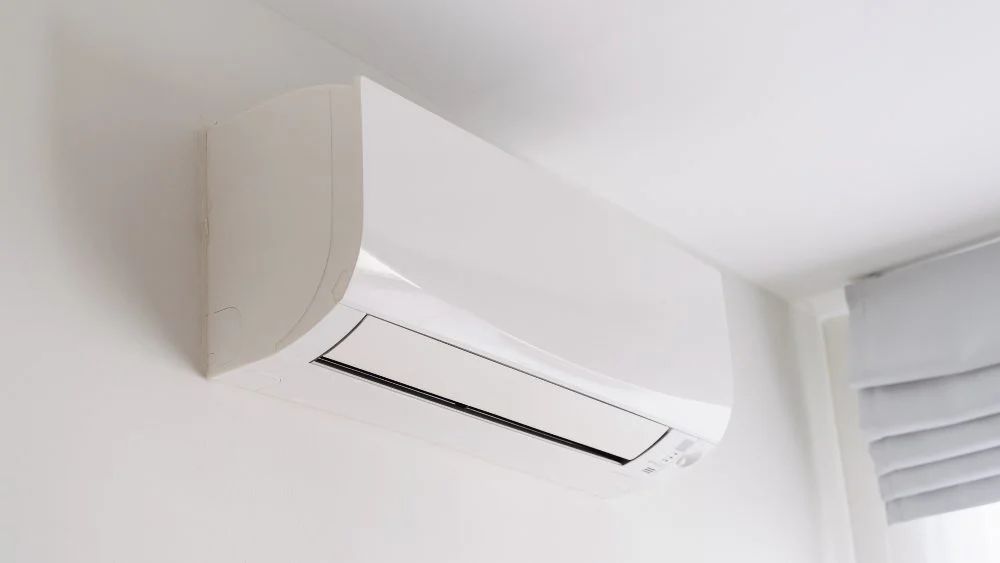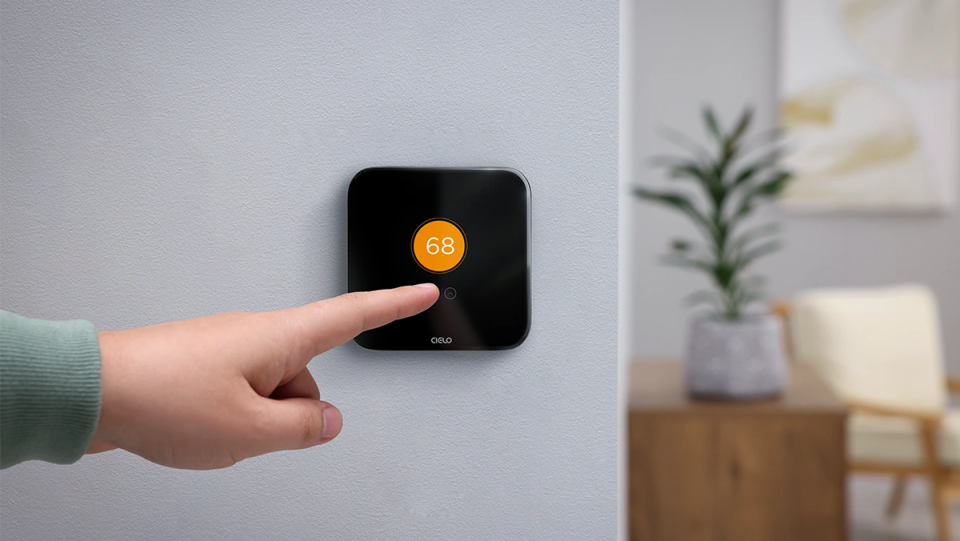
Key Takeaways
- Mini-splits and window units are versatile ductless options.
- Window ACs are cheaper and easier to install but less efficient and noisier.
- Both can be made smart with smart thermostats for ductless systems.
Choosing the right air conditioning system can significantly impact your comfort and energy efficiency. If you can’t install central AC for any reason, mini-splits and window AC units emerge as the top choices.
This mini-split vs. window AC blog will examine each unit’s pros and cons and compare them based on factors such as cost, energy efficiency, noise level, cooling capacity, maintenance, and installation. By examining these criteria, you will be better equipped to choose the unit that best suits your needs and preferences.
What Is a Mini-Split?

A mini-split system is a heating and cooling unit that consists of two main components: an outdoor compressor and an indoor air-handling unit. Unlike central HVAC systems that use ducts to distribute air, mini-split ACs are ductless systems, which means they can be more flexible in installation and are often used in situations where adding ductwork is impractical or impossible.
Related: Ducted vs. Ductless Air Conditioning Systems
Depending on your requirements, you can install a single-zone mini-split unit, where a single indoor unit is connected to the outdoor unit. Or you can have a multi-zone system, where you can install up to four indoor units with a single outdoor unit.
Consider investing in a smart mini-split thermostat to control your home climate with ease. It lets you manage your AC settings effortlessly from anywhere using your phone while providing you with numerous smart features.
Your best choice to make any mini-split, window,
or portable AC smart. Enhance your comfort and savings.

| Pros | Cons |
|
|
|
|
|
|
What Is a Window AC?

A window AC unit is a small, self-contained cooling system specifically built to cool a single room or area. It is installed directly into a window frame and incorporates all necessary parts—such as the compressor, condenser, evaporator, and fan—within a single unit.
Most units have controls on the front panel to adjust temperature settings, fan speed, and other features like timers and sleep modes. Some models even come with a remote control option. A better option is to pair your unit with a window AC thermostat, as you can easily make adjustments using your phone.
| Pros | Cons |
|
|
|
|
|
|
Mini-Split vs. Window AC: Key Differences
Here is a comprehensive overview of all the determinants that will help you make the decision-making process easier.

-
Cooling Capacity
Mini-Split:
When it comes to cooling larger spaces or whole homes, mini-split systems outperform window units in terms of airflow and cooling capacity. Mini-splits are designed to distribute air more effectively in relatively bigger rooms.
Window AC:
Window air conditioners typically have a limited range of cooling capacities. They are designed to cool single rooms or small spaces effectively.
Related: What Size Air Conditioner Do I Need?
-
Efficiency
Mini-Split:
A mini-split air conditioning system may has a higher initial cost than a window unit, but it proves its worth over time through exceptional energy efficiency. For instance, mini-splits consume 40% less energy than an average window unit, leading to significant savings on electricity bills.
Window AC:
Window air conditioners are generally less efficient compared to other cooling systems like mini-splits or central air conditioning. While window ACs are convenient for cooling individual rooms, they can lead to higher energy consumption and less effective cooling, especially in larger spaces.
Related: Why Is My Electric Bill So High?
-
Noise Levels
Mini-Split:
Mini-split air conditioners are significantly quieter compared to window units. This is because the noisy components, like the compressor, are located in the outdoor unit, away from the living spaces.
Window AC:
Window air conditioners tend to be noisier due to their all-in-one design, where both the compressor and fan are housed within the same unit. This design means that the operational noise, including the humming of the compressor and the sound of the fan, is emitted directly into the room. The noise level can vary, but it is generally more noticeable and can be disruptive, especially in quiet environments such as bedrooms or offices.
Related: How to Reduce Air Conditioner Sound for Peace and Quiet
-
Installation
Mini-Split:
Mini-split systems require more extensive installation work, including electrical wiring and refrigerant lines. However, if you know your way around technical components, you can install a mini-split yourself and save yourself the installation cost.
Window AC:
Window ACs have an edge over mini-splits when it comes to installation. Installing a window air conditioner yourself is straightforward, provided you take the necessary precautions. This includes measuring the window space beforehand and having someone nearby to help you insert the unit. Here’s a detailed guide on how to install a window AC in your room.
-
Design and Aesthetics
Mini-Split:
Mini-splits can be installed in various ways. You can install the outdoor unit discreetly on your property to minimize its visibility. Indoor units are available in a variety of designs and can be mounted high on walls, near the floor, or even within the ceiling, depending on what suits your aesthetic preferences. If, for any reason, the indoor unit clashes with your decor, there are a variety of ways to camouflage your mini-split.
Window AC:
Window ACs can be unsightly, as they protrude from a window and block the view. However, you can employ a variety of ways to creatively hide your window AC unit both inside and outside.
-
Cost
Mini-Split:
Mini-split systems are typically more expensive than window ACs, and their installation costs range between $1,200 and $16,400. Despite the higher initial investment, mini-splits are more energy-efficient and can lead to significant savings on electricity bills over time
Window AC:
Window air conditioners are generally more affordable upfront, making them a cost-effective option for immediate cooling needs. The initial purchase price with installation typically ranges from $150 to $550 per unit.
-
Maintenance and Care
Mini-Split:
The filters must be cleaned every two weeks and replaced every 3-4 months. Also, clean the coils regularly with warm water and soap solution. Make sure that the outdoor unit is clean and there are no obstructions around it. Ensuring the HVAC system functions efficiently not only maintains air quality but also helps prevent health risks.
Window AC:
Preventative maintenance for a window AC is not much different from that for a mini-split. You have to clean the filters and coils regularly. Also, dust the outdoor part of the window AC. Spray the interior and exterior housing with hydrogen peroxide solution to prevent mold growth. Here’s a detailed guide on window AC cleaning.
Both window AC units and mini-split systems should be inspected by a professional HVAC technician at least once per year to ensure proper operation and to address any issues before they become major problems.
Read more: Stay on Top of Your HVAC Maintenance Needs in 2024
-
Lifespan
Mini-Split:
Mini-split air conditioners generally have a longer lifespan, often ranging from 15 to 20 years with proper maintenance.
Window AC:
Window air conditioners typically have a shorter lifespan compared to other cooling systems. On average, a well-maintained window AC unit can last between 8 to 10 years. Factors such as frequency of use, maintenance practices, and environmental conditions can affect their longevity.
Here’s a guide to help you increase the average lifespan of your air conditioner.
-
Resale Value
Mini-Split:
Mini-split systems generally hold their value better than window air conditioners. These mini-splits are designed for durability and efficiency, making them more desirable in the second-hand market. Buyers are willing to pay more for a used mini-split due to its advanced features and superior energy efficiency.
Window AC:
Window air conditioners generally have a lower resale value due to their shorter lifespan and the rapid advancement of technology in the HVAC industry. As these units age, their efficiency and performance typically decline, making them less attractive to potential buyers. Additionally, the relatively low initial cost means that the potential return on resale is minimal.
Summing Up
Window AC units are cost-effective, easy to install, and suitable for cooling individual rooms or small spaces. On the other hand, mini-split systems provide greater flexibility, energy efficiency, and quieter operation, albeit at a higher initial cost. Ultimately, when it comes to mini-split vs. window AC, the choice should be guided by factors such as budget, installation requirements, and desired level of efficiency.








